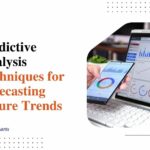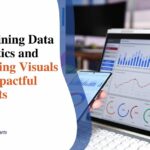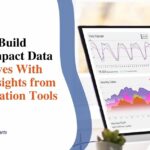Create 5 Captivating Data Stories with Visual Concepts Using Visualization Tools
Data visual concepts can bring numbers and statistics to life through impactful narratives that engage audiences. By thoughtfully crafting compelling data stories, we can uncover key insights, highlight relationships, and display trends and geographical patterns. This enables better communication of complex data findings to stakeholders.
In this post, we’ll explore five captivating ways to tell data stories using various visual concepts and techniques.
Data Story 1: Revealing Trends and Patterns
Uncovering trends and patterns is one of the most popular data visualization applications. Plotting time series data online or in area charts can reveal intriguing trends and fluctuations.
To craft an engaging data story with trends, carefully follow these steps:
a. Choosing the Right Dataset
Select a time series dataset that shows potential for trends, such as website traffic, sales figures, or social media engagement over time. Granular, frequently-captured data works best.
b. Identifying Key Trends and Patterns
Plot the time series on a line or area chart. Analyze whether there are any rising/falling trends, seasonal/cyclical patterns, or abnormalities. Interesting insights include rapid growth, declines, peaks, and troughs.
c. Selecting Appropriate Visualization Tools
Line and area charts plotted against a time axis are the simplest visual concepts. Include interactive features like tooltips. Advanced charts like slope graphs and small multiples can also elegantly highlight trends.
d. Crafting a Compelling Narrative
Contextualize the major trends discovered through visual storytelling. Hypothesize what could drive rapid increases/decreases, seasonal peaks, and other patterns. This brings the numbers to life.
Data Story 2: Comparing and Contrasting Datasets

Comparison visualizations juxtapose two or more datasets, revealing intriguing similarities and differences. This drives richer analysis and insights.
Follow these steps for impactful comparative data stories:
a. Identifying Datasets for Comparison
Determine which datasets can yield interesting comparative insights if visualized side-by-side. Comparing financials annually, employee metrics, or website analytics across products/regions reveal variances.
b. Choosing Suitable Concept Visualization Tools
Column/bar charts overlayed or clustered in groups of two or more datasets make comparison intuitive. More advanced options include radar plots for benchmarking metric values in a multi-dimensional space.
c. Highlighting Key Variances
Compute the variance between data points of the datasets being compared. Through annotations, color coding, sorting, and other emphasis techniques, call out the biggest similarities and deltas.
d. Deriving Meaningful Conclusions
The narrative is vital – contextualize why the similarities and differences matter, what could drive the variances, and what actions they prompt. Pose thoughtful questions to spur further analysis.
Data Story 3: Visualizing Relationships and Correlations
Examining potential relationships and correlations between datasets can yield profound and actionable insights through compelling data stories.
Here is an effective approach:
a. Selecting Relevant Datasets
Identify datasets with logical linkage but no visible interdependence. Plotting these on a shared canvas could unveil hidden correlations, such as marketing expenses and sales.
b. Visualizing Potential Relationships
Scatter plots with dataset values plotted along the X and Y axes make correlations visible as data points cluster in specific patterns. Consider bubble charts, heat maps, etc.
c. Explaining Observed Correlations
Measure the statistical correlation using regression analysis. Based on the data point patterns, explain whether relationships are weakly/strongly positive/negative through annotations.
d. Deriving Actionable Insights
A scatter plot shows correlation but not causation. Adding context about the datasets, share intelligent hypotheses about why a causal relationship could drive the observed correlation.
Data Story 4: Visualizing Geographical Data
Spatial data visual concepts like maps powerfully showcase regional, demographic, and geospatial trends. Crafting data stories on maps can instantly highlight growth pockets, inequities, and more.
Effective approaches include:
a. Obtaining Relevant Geographical Datasets
Identify regional demographic, social, health, or financial datasets with adequate geographic granularity to yield interesting geospatial insights.
b. Employing Maps and Geospatial Impactful Visuals
Choropleth maps shade different regions based on metric values to depict geographical patterns. Heat maps and cluster maps represent densities and concentrations.
c. Identifying Patterns and Disparities
The regional differences should be self-evident on the maps through variations in shading/clustering. Call out the highest/lowest concentration areas and outlier regions through annotations.
d. Deriving Location-based Insights
Offer hypotheses regarding the societal, cultural, and economic drivers causing geographic disparities. Suggest potential actions, such as increased investments in high-need areas.
Data Story 5: Visualizing Hierarchies and Categories
Hierarchical and categorical data with interesting distributions can be effectively visualized through indentation-based tree maps and radial sunburst charts.
Here is one approach:
a. Identifying Categorical or Hierarchical Datasets
Select datasets where grouping data into hierarchical categories (e.g., org structures, product taxonomies) or visualizing categorical frequency distributions (e.g., customer segmentation, sales by product line) can offer insights.
b. Choose Suitable Categorical Visualizations
For hierarchies, nested rectangular treemaps sized by metrics like revenue, employees, etc, reveal concentration. Sunbursts radially divide rings sized by categories.
c. Highlight Category Concentration
The categories should be sized appropriately based on assigned metrics like population/revenue. Use color coding to distinguish categories and call out the biggest segments.
d. Deriving Category-based Insights
Explain category/sub-category shares of the whole (100%). Call out dominating and underperforming segments. Share hypotheses regarding performance drivers based on category characteristics (e.g., pricing, positioning, etc.).
The Bottom Line
Data visual concepts powerfully complement analytics and enable the conveying of insights through compelling stories. Impactful narratives can be crafted around data by following the genre-specific best practices outlined above for visualization data concepts like trends, comparisons, correlations, maps, and hierarchies. The key is asking the right questions of data and uncovering insights that influence strategic decision-making through engaging data stories.







